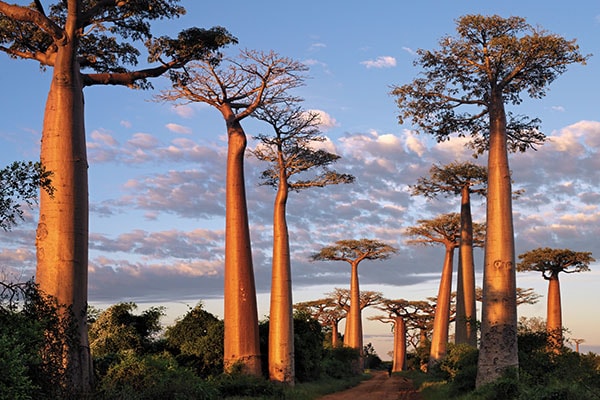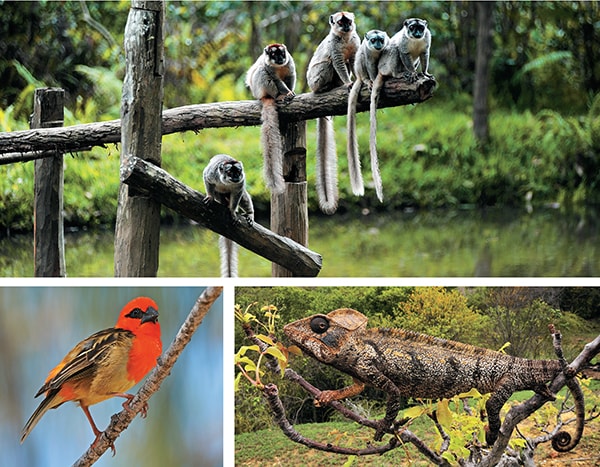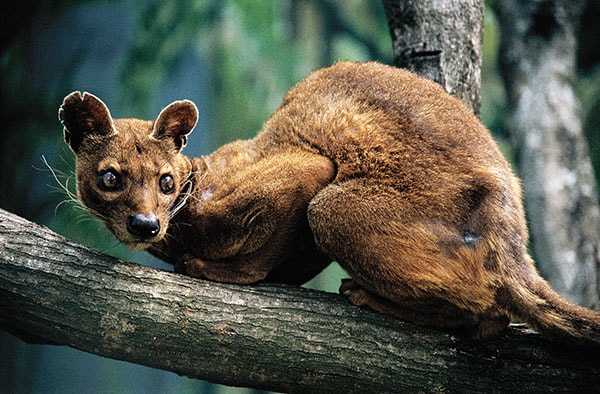
Madagascar's unique wildlife
The country's natural history, especially its birds and lemurs, is matchless on the planet
We are at Vohipara, a marshy area in the montane rainforest of the Ranomafana National Park in Madagascar. Our guide, Wednesday, is playing bird calls on his ancient Sony Walkman. He fast forwards and rewinds to unerringly find the right birdsong. And the effect is astonishing.
In a couple of hours, he calls in over 30 species, many unique to Madagascar. They include several species of vangas—Red-tailed, Hook-billed, Pollen’s, White-headed, Blue and Tylas. If Charles Darwin had studied Madagascar rather than the Galápagos Islands, then the vangas’ diversity and distinctive beaks—adapted to specific habitats and food—would have made them, and not the finches, figure prominently in his theory of evolution.
Madagascar’s natural history, especially its birds and lemurs, is like nothing else on the planet. In 1771, French naturalist Joseph Philibert Commerson described it as: “[The naturalists’] promised land… Nature seems to have retreated into a private sanctuary to work on models other than those she created elsewhere. At every step, one encounters the most strange and marvellous forms.”
Madagascar is the world’s fourth largest island. Isolated for about 80 million years, wildlife, other than man, evolved from ancestors trapped on the island or from life which found its way here across the ocean. Isolation meant the absence of diluting influences, allowing the evolution of distinctive species.
A high central mountain range creates different environments: Wet in the east and much drier in the west and south. Flora and fauna have evolved to occupy the different climatic zones. The combination of isolation and different environments creates a high level of endemism, with around 80 percent of life forms unique to Madagascar.
But the former French colony is not an easy place to visit.
Internal air travel on Air Madagascar, tellingly known as ‘Air Mad’, requires negotiation of eccentric route structures and unpredictable changes in schedule. Roads are poor and frequently unsealed. The trees have a surreal look and are stained reddish-brown from the constant dust. On the main road going north from Morondava, we have to cross the river on a car ferry, which only runs when there are sufficient cars, necessitating lengthy waits.
For a part of our journey, we are shadowed by two adventurous elderly women from Italy who are travelling alone. Undeterred by the challenges and eschewing the pleasures of the beach resorts in the north favoured by French tourists, the stoic women, like us, are exploring Madagascar’s natural history.

Image: Corbis
The Avenue of the Baobabs is a cluster of 20 trees, which rise to about 30 metres
Spines and stones
Our trip takes place in different landscapes: Rainforest, deciduous forest and semi-desert.
The harsh and arid south is dominated by a spiny bush (the spiny ‘forest’), a cactus-like deciduous thicket that has evolved a strategy of thorns for retaining water and deterring predators. Once covering much of the south and west, only a few small pockets of this landscape—in Ifaty forests near the city of Toliara, and the private Berenty Reserve near the city of Tolagnaro—remain.
The drier areas also have bottle trees, like baobabs, which store water to survive in this harsh climate. Outside of the west coast town of Morondava, there is the much-photographed ‘Avenue of the Baobabs’, a cluster of about 20 trees that line a dirty road: They rise to about 30 metres and go back some hundreds of years.
At the Isalo massif—a compact group of mountains inside the Isalo National Park in central Madagascar—we walk for about eight hours in 40 degrees centigrade through a spectacular landscape of eroded sandstone, canyons and hidden waterholes.
But the highlight is the Tsingy de Bemaraha National Park, north of Morondava: It is a large eroded limestone massif that now forms pinnacle karsts. Starting at dawn, we scale the Tsingy. The rock is razor sharp and impenetrable in parts. Squeezing through tiny crevices, we climb rock ladders secured by harnesses and cross ravines on suspension bridges to reach the top, to be sufficiently rewarded by impressive views.
Changing colours
Madagascar has 80 known species of chameleons. We see the large Parson’s and Oustalet chameleons, which are around 65 cm (more than 2 feet) in length. We also see many smaller varieties, some only a few centimetres long.
They are easiest to see at night, asleep at the end of branches to avoid predators. Under torchlight, they change colour from very pale into darker tones of green and brown. Cells containing pigments help chameleons change colour, thought to signal states of relaxation, fear, distress or sexual excitement.
Close up, the chameleons are fantastical. Their noses have distinctive bumps and prongs. Their large eyes can swivel independently, enabling them to stay still and track both potential prey and threats all around. Their toes are fused together, forming two opposing sets to provide good grip. They move in a slow rocking motion.
I watch an Oustalet chameleon fire its tongue, almost as long as its body, like a spear, with astonishing speed. The muscular tip of the sticky tongue wraps around an insect, securing the prey.
The most interesting reptiles are the leaf-tailed geckos. Their skin colour and patterning allows them to blend into tree trunks or leaf litter to avoid detection by predators.
Birds of many feathers
We see around half of Madagascar’s 280 known bird species. Alongside the vangas, there are the attractive and colourful thrush-like ‘ground rollers’ and several types of Couas, which have long, broad tails, and featherless blue skin around their eyes.
At Andasibe-Mantadia National Park, near the capital city of Antananarivo, we see a beautiful adult male Velvet asity very close; its extraordinary bright green wattle lined with sky blue above its eyes is clearly visible. At Ampijoroa Forest Station, near Mahajanga, a rare Schlegel’s asity flies near us, its lime green and blue wattle shimmering like tinfoil in the sun.
There are brightly coloured Red Fodys, bee-eaters and malachite kingfishers as well as drab-looking vasa parrots. In marshes, we see rails (small water birds often referred to by birders unkindly as ‘wet chickens’), including a skulking Madagascar flufftail. Our successful spree continues with the terrestrial rail-like mesites, including the threatened Subdesert mesite. We are fortunate to see a rare Henst’s goshawk and the critically endangered Madagascar fish eagle.
We set out before dawn to track down the rare Short-legged ground roller, a small thickset bird with a puffed-out throat. The bird only calls at dawn, so we need to be in the forest early to have any chance of seeing it. Our guide detects a faint call and plunges through the forest. We follow, negotiating thick foliage, wading across small streams and, on one occasion, receiving a piggy-back ride across a creek on our guide. After about 40 minutes, we find the bird perched on a low branch.
In the spiny bush of Ifaty, we are forced to enlist some locals to help us track down the elusive, equally rare Long-tailed ground roller. At one stage, I lie flat on the ground trying to spot the bird under some bushes. After a lengthy chase the roller runs into the open, offering us a short but good view.
Other birds are more obliging: A tiny Appert’s Greenbul, a much sought-after bird, hops into view just off the trail at Zombitse-Vohibasia National Park within minutes of us arriving; while a pair of Cuckoo rollers perch on a branch above a forest path in clear view. The male’s green and purple upper parts glow iridescent in the morning light. We hear his display call consisting of a series of whistles which drop in tone and volume.
Funny Walks…
Madagascar’s lemurs provide endless fascination.
Classed as prosimians (creatures with characteristics that are more primitive than that of monkeys), a classification shared with African Bushbabies and Asia’s Lorises and Tarsiers, Madagascar’s lemurs are primates who arrived from the mainland, evolving into a wide variety of species specially adapted to their habitats.
Due to a major taxonomic review, today there are around 90 species of lemurs, up from around 30 to 40 that were recognised 20 years ago: There are the large black-and-white teddy bear-like Indris; nine species of Sifakas; there are Woolly lemurs, True lemurs, Brown lemurs, Ruffed lemurs, Bamboo lemurs, tiny Mouse and Dwarf lemurs, the (weasel-like) Sportive lemurs and the unique Aye-Aye. Differing in size, diet and habits (some are nocturnal while others are diurnal), what they have in common is soft fur, big bright round eyes, kid-gloved hands and (in most cases) dog-like noses.
At the Ranomafana National Park, over a couple days, we see the park’s most famous residents—the grey Eastern Lesser Bamboo lemur, the recently discovered Golden Bamboo lemur and the Greater Bamboo lemur, all known for their specialised diet of bamboo. But the most endearing are the Sifakas and Ring-tailed lemurs.
The commonly seen Verreaux’s and Coquerel’s Sifakas are mostly white with small patches of chestnut or chocolate fur, and yellow eyes. Large, with smallish arms, but long powerful legs, they travel through the forest canopy with incredible speed, covering hundreds of metres in a few seconds. They move in bounding leaps from tree to tree with great precision.
Their build makes Sifakas awkward on the ground: They bound sideways on their hind legs, immortalised by John Cleese in Monty Python’s The Ministry of Silly Walks. They are a joy to watch, providing us with hours of delight.
The Ring-tailed lemurs are ironically atypical, spending extended periods on the ground and forming large groups dominated by a breeding female. But the sight of them walking in single file with their raised tails or sitting with their arms spread apart warming themselves remain iconic.
Although we have been able to spot around half of all the lemur species, the Aye-Aye eludes us. It has a unique, elongated, extremely thin middle finger which is used to probe gnawed-out holes in trees, extracting insects from within. Thought to have evolved to fit the evolutionary niche occupied elsewhere by woodpeckers (which are absent from the island), it is emblematic of Madagascar’s unique wildlife.

Clockwise from top: A group of Verreaux’s sifakas; an Oustalet chameleon and a Aldabra Fody (male) at the Montagne des Français Reserve in Madagascar
Close encounters
At the Kirindy private reserve, north of Morondava, one of the island’s most interesting wildlife destinations, our accommodation is primitive.
During our stay, there is a commotion involving a young American woman who has just arrived. She was lying on the bed in her hut, reading, with the windows open. A large rat had jumped up on the bed, perhaps curious about her reading interests. The woman had not been sympathetic to the rodent’s presence or inquiry. But I was more interested in knowing whether it is the Malagasy Giant Rat, unique to Kirindy. Unfortunately, it was something more common.
Her guide explains that this is a jungle with wild animals. The woman is not convinced and wants to go and stay at the nearest hotel some 200 km away. She ends up leaving the next morning, having spent the night locked in their car with the windows up during an incredibly hot night.
A BBC crew member filming at Kirindy tells us a rat is a nightly visitor to her hut, eating anything and everything including her malaria tablets.
On our first night at Kirindy, Jade, my partner, and I are awakened by a persistent rustling. I confidently assume it is something on the thatched grass roof of the hut. As the noise continues, I turn on my torch.
I am eye-to-eye with a Madame Berthe’s mouse lemur, only found at Kirindy. It is the smallest primate in the world, around 8 to 9 cm long and weighing around 20 to 30 grams. We open all the doors and windows and the mouse lemur leaves.
As it is almost dawn, we decide to get up. I wash, splashing myself with a cup from a large drum of water and dress in yesterday’s smelly clothes. Once outside, assuming that at this early hour no one will be around, I go behind a tree to relieve myself, avoiding the smelly pit toilets. I feel that I am being watched. Glancing over my shoulder, I find the voyeur: A female fossa, the largest carnivore in Madagascar and the principal reason for our visiting Kirindy.

Chris Hellier / Corbis
An alert fossa (Cryptoprocta ferox), Madagascar’s largest mammalian carnivore
The fossa is about 1.5 metres in length, perhaps 35 to 40 centimetres in height and less than 10 kg in weight. It is dark brown with a small head and a small muzzle. Its large eyes are looking calmly at me.
After a few seconds, it walks away. I rush to get Jade. Together we search the camp and find the fossa at the water tank near the centre of the camp. Habituated to humans, she uses the camp as a watering hole. Finishing her drink, she takes a look around the camp and then walks into the forest.
We see her a few more times during our stay, once with another fossa, possibly a juvenile.
Later in the trip, scaling the Tsingy de Bemaraha, we hear a coarse, rasping sound. It is another female fossa in a tree. Equipped with reversible ankles designed to allow it to grasp trees and branches from both sides, fossas are agile climbers, able to move rapidly through the canopy, usually to hunt arboreal prey such as lemurs.
We suspect this is a fossa mating tree where she may sit awaiting males who bring her food to vie for her attention. We soon notice a male fossa nearby, with characteristic orange underparts.
The excited guide later tells us that the last fossas were seen here more than five years ago.
The Indri’s Call
Madagascar’s incomparable beauty and unique wildlife is under threat from destruction and degradation of habitat and hunting. Driven by overpopulation, extreme poverty and poor slash-and-burn agricultural practices, the Malagasy are rapidly turning the island into a sterile and barren wasteland. Over 90 percent of the original forest is gone. Conservation is cursory and only lip service is paid to preservation of this Eden.
One of the sounds of Madagascar’s forests is that of the Indri. The eerie song, audible up to 2 km away, can be heard several times through the day. The Indri calls to maintain contact or advertise territorial claims. Sometimes, males and females synchronise their calls, effectively singing duets that may last for several minutes. At Mantadia, we hear them calling several times. The song seems to me a plea, a call for human understanding and respect to allow these unique creatures to continue an existence that dates back millennia, far before humans walked the earth.
© 2015 Satyajit Das All Rights Reserved. Satyajit Das is a former banker and author of Traders Guns & Money and Extreme Money. He is also the co-author with Jade Novakovic of In Search of the Pangolin: The Accidental Eco-Tourist.
(This story appears in the 30 November, -0001 issue of Forbes India. To visit our Archives, click here.)







